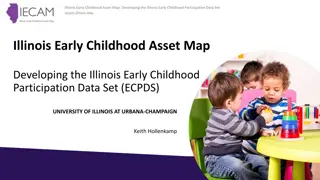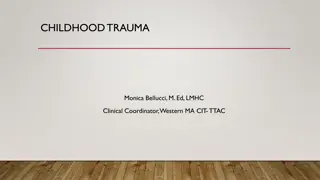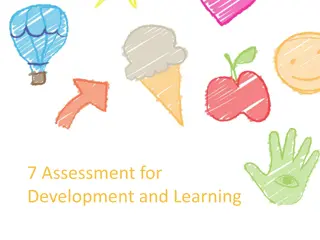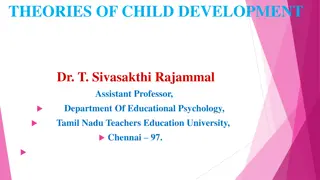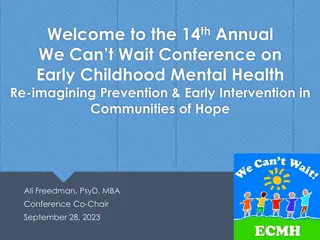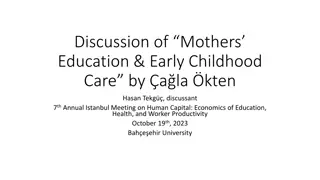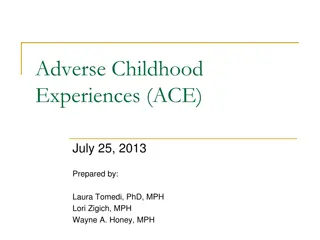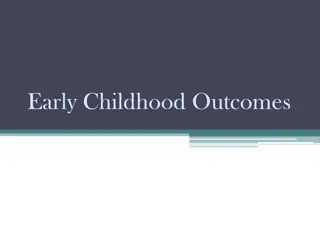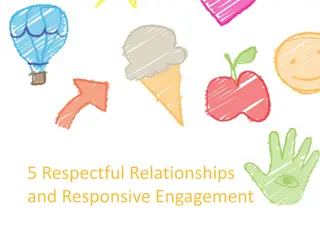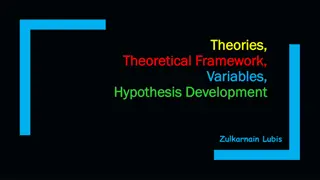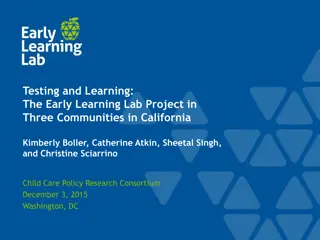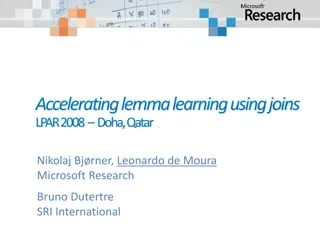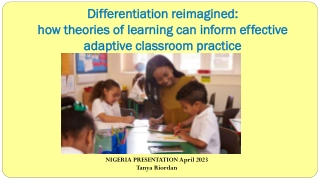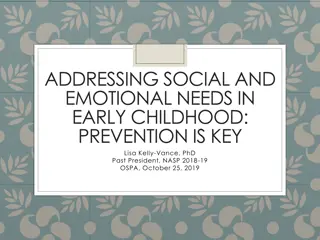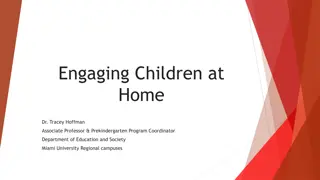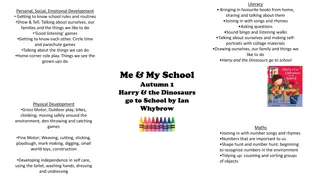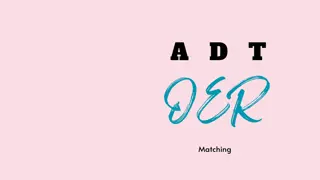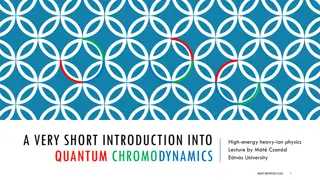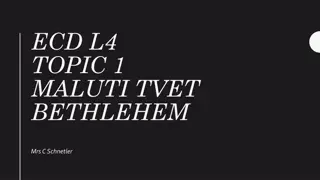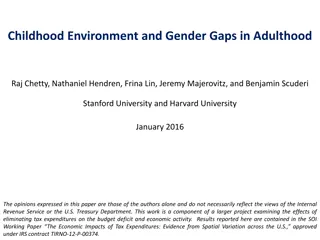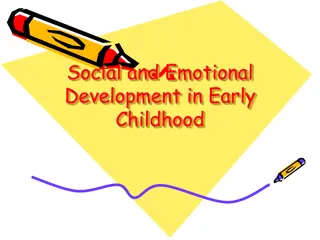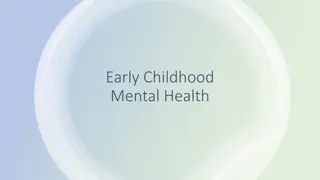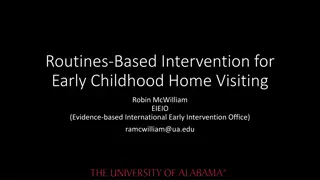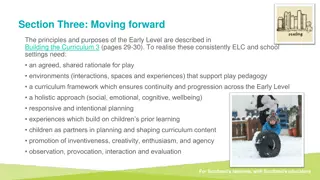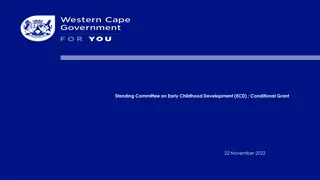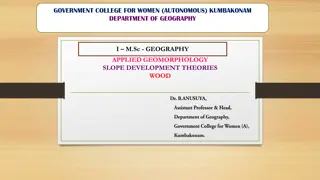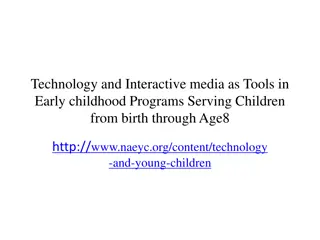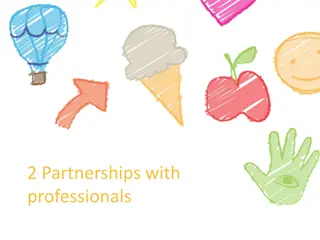Understanding Early Childhood Development Theories for Effective Practice
Explore the impact of different theories and philosophies on early learning and development in children. Understand how these theories influence assessment, curriculum, intervention, and instructional decisions. Delve into the nature vs. nurture debate and learn about key theorists shaping Early Interventionists/Early Childhood Special Educators' practices.
Uploaded on Sep 21, 2024 | 0 Views
Download Presentation

Please find below an Image/Link to download the presentation.
The content on the website is provided AS IS for your information and personal use only. It may not be sold, licensed, or shared on other websites without obtaining consent from the author. Download presentation by click this link. If you encounter any issues during the download, it is possible that the publisher has removed the file from their server.
E N D
Presentation Transcript
Child Development and Early Learning Initial Practice-Based Professional Preparation Standards Early Interventionists/Early Childhood Special Educators 1.1
Standard 1 Candidates understand the impact of different theories and philosophies of early learning and development on assessment, curriculum, instruction, and intervention decisions. Candidates apply knowledge of normative developmental sequences and variations, individual differences within and across the range of abilities, including developmental delays and disabilities, and other direct and indirect contextual features that support or constrain children s development and learning. These contextual factors as well as social, cultural, and linguistic diversity are considered when facilitating meaningful learning experiences and individualizing intervention and instruction across contexts.
Component 1.1 1.1 Candidates demonstrate an understanding of the impact that different theories and philosophies of early learning and development have on assessment, curriculum, intervention, and instruction decisions
Objectives Describe key theorists and their theories on early development and learning that influence EI/ECSE Describe the influence of theories on early development and learning on assessment, curriculum, intervention, and instructional decisions
Theory Defined as an orderly, integrated set of statements that describes, explains, and predicts behavior Influenced by cultural values and belief systems Continued existence depends on scientific verification: Set of research procedures agreed by the scientific community Endure or replicated over time
Nature vs. Nurture Child Development Theories Nature All genes and hereditary factors influence who we are and are not likely to vary much across a lifetime Physical traits, personality characteristics, intellectual or creative traits Heredity is most important
Nature vs. Nurture continued Nurture Environmental variables impact who we are How we are raised Social relationships Surrounding culture
Behavioral and Developmental Theory Behavioral theory: the core of special education research and practice Developmental theory: informs application of practices to young children and early learners Piagetian Theory Vygotskian Theory Attachment Theory
Systems Theories Ecological and Transactional Models Sameroff: Transactional Model Bronfenbrenner/Ecological Systems of Theory Neuroscience of Early Childhood
Foundations of Behavioral Theory Directly observable events are only appropriate targets of the study of child learning and behavior Measurable stimuli and behavioral responses Originated with Pavlovian experiments with dogs to demonstrate classical conditioning
B.F. Skinner Developed Operant Conditioning reinforcers and punishers can be developed to individualize and modify response behaviors Led to broader use of behavior modification interventions, primarily tested in clinical settings on older children and adults with cognitive impairments
Applied Behavior Analysis (ABA): Key Concepts Three-part contingency (antecedent-response- consequence) Systematic use of behavioral strategies - modeling, prompting, shaping, chaining, and differential reinforcement to support positive outcomes Fidelity use of functional behavior assessments and development of appropriate behavior intervention plans
ABA Key Concepts Data collection guides assessment, planning, intervention, and evaluation. Supports appropriate behavior by teaching new skills Modifies the environment to prevent challenging behavior Puts prevention strategies in place before new behaviors occur
Activity After watching the video on the next slide, discuss the assessments and interventions used in EI/ECSE that are based in behavioral theory
Video: A Look at Behaviorism https://youtu.be/eLaa8cgljKk
The Developmental Perspective Behavioral practices for individuals with disabilities originally developed for older children and adults in highly controlled circumstances Increased focus on early learning and intervention for young children in the context of caregiving required a blending of theories Modern EI/ECSE practice grounded in multiple theories
3 Developmentally-Based Theories Piaget: Cognitive developmental theory Vygotsky: Sociocultural theory Attachment Theory
Jean Piaget: Cognitive-Behavioral Framework One of the most influential theorists of modern child developmental theory Did not believe that child learning required the use of reinforcers such as praise or rewards from adults First to closely study the way children actively engaged with the physical world to learn
Schemas: Frameworks for Understanding Building blocks of knowledge Helps children organize and make gradually more complex meaning of the world Children gradually transition from simpler ways of understanding to more complicated ones, using a string of organizing experiences over time
Piaget: 3 Basic Concepts Schema: a mental structure we use to organize our perceptions and memories Assimilation: use of existing schemas to build on our stores of knowledge and skills Accommodation: building or creating new schemas (involves deeper change)
Piaget: 4 Stages of Development STAGE PERIOD OF DEVELOPMENT Birth 2 years DESCRIPTION Sensorimotor Explores with all senses, hands, mouth. Works out making things happen (cause and effect), finding hidden objects, filling and emptying Preoperational 2-7 years Begins to use symbols, language, pretending, story- telling Concrete Operational 7-11 years Logic and reasoning become more organized: interested in classifying objects into hierarchies Formal Operational 11 + Abstract and systematic thinking requiring higher-level cognitive processes
A Look At Piaget https://youtu.be/IhcgYgx7aAA
Activity As a group, discuss assessments you have used that incorporate Piaget s stages as a means of describing a child s cognitive development. How can knowledge about each of these stages provide useful information for IFSP/IEP planning?
Sociocultural Theory: Vygotsky Believed that knowledge takes place in the context of social interactions Through interactions with others, children acquire the capacities and skills they need in the context of their own culture
More Knowledgeable Other Adults, older siblings, cousins, and peers serve as more knowledgeable others They provide a rich variety of expressions, gestures, sounds and language to communicate about how to survive and thrive
Proximal Zone of Development He believed that adults naturally scaffold child learning through interactions that are appropriate to the child s readiness
Vygotsky: Sequential stages 1. Face to face interaction 2. Joint attention 3. Acquire the use of symbols (gestures, sounds, language) 4. After language acquisition, increased interactions with adults/peers develop higher order capacities
Video: A look at Vygotsky https://youtu.be/8I2hrSRbmHE
Activity As a group, discuss how the concept of proximal zone of development can be used to inform IFSP/IEP planning
Harlows Experiments Series of studies in the mid-1900 s Young primates sought connection and comfort over food sources Described the concept of early bonding in other animal species
Attachment and Regulation From an Adult Are Primary Needs Babies are hard-wired to seek proximity to their mothers at birth Through touch, rocking, singing, and caregiving, adults in virtually all cultures respond to the distress of infants and toddlers to restore them to a regulated state
Mary Ainsworth: Patterns of Attachment Used the Strange Situation Paradigm Recorded and validated attachment styles: Secure Insecure: Avoidant Insecure: Resistant/Ambivalent Insecure: Disorganized/Disoriented
Video: A Look at Attachment Theory https://youtu.be/WjOowWxOXCg
Transactional/Ecological Theories Merging behavioral, developmental and systems theory into a unified theory of child development
Transactional Model: Sameroff Nature and nurture both influence development through a constant interactive process Inborn and environmental forces shape development in a bi- directional and transactional manner
Bronfenbrenner: Ecological Systems Theory Importance of emotionally connected caregiving relationships the need for safety and stability within families support emerging development A dynamic system involving both the child s biological makeup and the collective forces of environment to shape development
Bioecological Model
The Microsystem Experiences and relationships at the level of the family environment, including home, neighborhood play areas, and childcare settings. Bidirectional
The Mesosystem Contains connections between elements of the microsystems home, neighborhood, childcare and recognizes the impact of each of these upon the other
The Exosystem Social settings outside of the child s family structures but impact experiences Formal support systems: religious, health care access, work-related benefits Informal support systems: friends and extended family
The Macrosystem Larger constellation of culture, world views, laws, customs and collective resources How leaders and systems prioritize the needs of children determine the experiences of children within the family
The Chronosystem Environmental influences that shape the experience of an individual across the life span
Neuroscience of Early Childhood Grounded in Sameroff s Transactional Model and Ecological Systems theory, the neuroscience of early childhood model is situated in the context of multiple theoretical models
Key Concepts: Neural Exuberance Brains begin to develop from birth and develop at an astronomical pace in the first months of life Over 1 million new connections per second First years of life are when the foundations of brain architecture are formed
Key Concepts: Serve and Return Early experiences support or constrain brain architecture Lay the foundation for all subsequent development Early and consistent serve and return interactions optimize development for children of all abilities
Video: Serve & Return Interaction Shapes Brain Circuitry https://www.youtube.com/watch?v=m_5u8-QSh6A
Key Concepts: Toxic Stress Early and continuing adversity and/or trauma can derail developing brain architecture
Video: Toxic Stress Derails Healthy Development https://news-mag.net/wp-content/uploads/2021/07/3-Toxic-Stress-Derails-Healthy-Development.jpg https://www.youtube.com/watch?v=rVwFkcOZHJw
Key Concepts: Resilience Why do some children do well in the face of adversity, and others do not? What determines how resilient a child is when faced with difficult circumstances?





